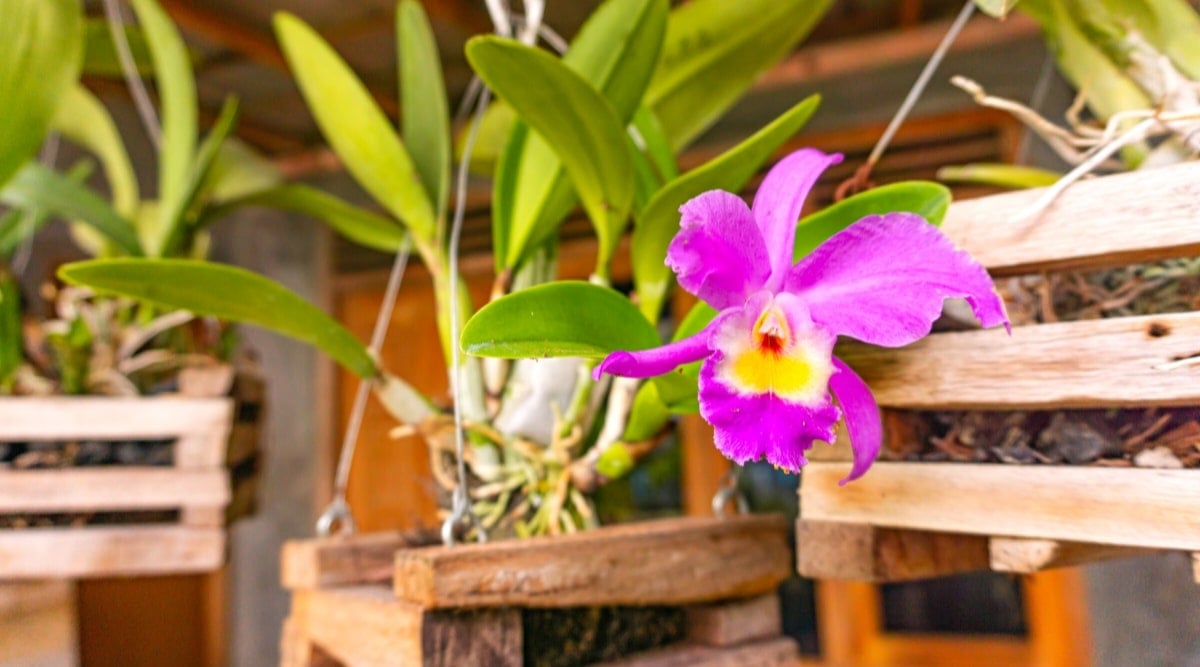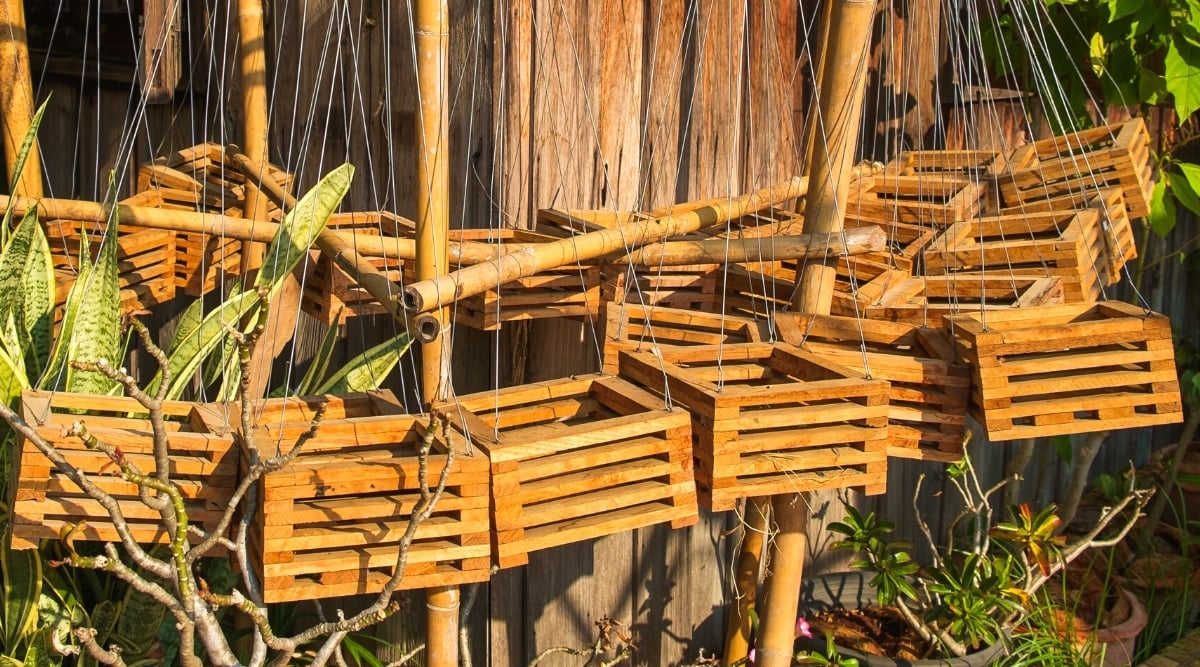9 Tips For Growing Beautiful Orchids in Hanging Baskets
Orchids can be picky plants when it comes to their growth habitat. So you may be concerned if you are trying to grow them in anything other than their natural environment. The good news is, hanging baskets are close to native environments for many orchid types. In this article, gardening expert and orchid enthusiast Melissa Strauss shares her top tips for beautiful blooming orchids in hanging baskets!

Contents
Orchids are such beautiful and exotic plants, it’s no wonder they are among the most popular houseplants. They make wonderful gifts, and it can be exciting to collect new and interesting cultivars. With more than 16,000 varieties in the Orchidaceae family, the possibilities are virtually endless.
Orchids don’t just have to sit on a table looking pretty, though. Orchids in their native environment frequently grow in trees and are, essentially, air plants. This makes them the perfect hanging plants. When planted in hanging baskets, orchids will be happy with their environment, and besides, hanging them makes more space for more orchids!
If you’ve been keeping your orchids in standing containers, transitioning to hanging baskets is a simple and straightforward process. Let’s discuss some tips for making that transition and amending your care routine to cultivate the healthiest orchids around.
Before I jump into giving you the tips you’ll need for successfully growing orchids in hanging pots, it’s important to understand a bit about some of their more complex terminology.
Important Orchid Terms
| Epiphytic | A non-parasitic plant that grows on another plant or object for support and is not rooted in the ground. |
| Terrestrial | Plants that grow in the ground. |
| Monopodial | A growth habit that moves continuously upward on a vertical stem or rhizome that produces leave and flowers. |
| Sympodial | A growth habit that runs on a horizontal rhizome that sends up pseudobulbs that produce leaves and flowers. |
| Pseudobulb | A bulbous structure on the stem of a sympodial orchid that produces leaves and flowers and stores energy for the plant. |
Tip #1: Choose the Right Variety

Although many commonly sold orchids are epiphytic, this is not a hard and fast rule, and it makes a big difference. Some genera of orchids are terrestrial, such a spathoglottis orchids. These plants grow in the ground rather than in trees, so their soil needs are different.
Since a terrestrial orchid grows in the ground, a hanging basket is not a natural choice. That doesn’t mean that you can’t make it work, but these tips specifically apply to epiphytic orchids.
If you are planting a terrestrial orchid in a hanging container, you will want to choose one with smaller drainage holes and use potting soil that is compatible with terrestrial orchids.
Orchids that work well in baskets include Cattleya, Phalaenopsis, Oncidium, Vanda, some Epidendrum and Dendrobium, and several other lesser-known varieties. Before deciding to pot your orchid in a hanging basket, make sure that it is indeed an epiphytic orchid.
Tip #2: Choose the Right Size and Type of Container

It is important to select the right type of container for potting an epiphytic orchid. These plants’ roots are exposed to the air in their natural environment, and as such, they require a sufficient amount of air circulation around their roots. Without this, the plant is more susceptible to root rot, which is the #1 killer of captive orchids.
The most important factor in choosing a container is proper drainage. If the water is not able to drain out completely, root rot will almost certainly become an issue.
When potting medium remains wet, it begins to decay and break down, compacting around the roots and becoming a breeding ground for fungus.
The most common type of orchid hanging basket is made from 2”x2” pieces of wood, which are joined together such that they are sandwiched between the pieces to either side. This means that the holes between the wood pieces are as wide as the wood pieces themselves. This type of basket allows for complete drainage as well as maximum air circulation.
Another factor to consider when choosing a container is whether the orchid is sympodial or monopodial. A sympodial orchid has a sideways growth habit, so it will need to be potted in a container that allows room for that horizontal growth.
Likewise, when potting, the oldest pseudobulb on the plant should be against the side of the container to all for that movement. Sympodial orchids include Cattleya, Dendrobium, Cymbidium, and Oncidium.
A monopodial orchid constantly grows upward, so it does not need extra room in its container for expansion. While the plant will get larger with time, a monopodial orchid will not need a larger container as often as a sympodial orchid will. Monopodial orchids include Phalaenopsis, Ascocenda and Vanda orchids.
Tip #3: Use the Right Potting Media

We are strictly discussing epiphytic orchids here, and they have specific and unique needs when it comes to their potting medium. Just as the container needs to have excellent drainage and space for air circulation, so too does the potting mix.
Pre-mixed orchid bark can be found in most places where orchids are sold. This is typically a combination of bark and charcoal, along with some other large particles such as pumice, sponge rock, or perlite. If you prefer to mix your own potting medium, start with about 60% bark and 20% charcoal.
There are a few issues with standard potting mix. The first is obvious when you consider the type of container. Standard potting soil would spill out of the holes in the orchid pot very quickly and make a mess.
In addition to the mess it would make, standard potting mix holds a lot of water, and as such, it creates an environment where the roots, which are susceptible to fungus, will become soggy and breakdown, creating vulnerability, Standard potting soils also compact easily, which prevents air circulation around orchids’ roots.
Tip #4: Secure the Orchid

Once your orchid has been potted in its hanging basket, it’s a good idea to secure the plant in the container until it has time to root. Eventually, their roots will grow through the potting mix and onto the actual container, securing the plant in place.
In the meantime, you may find that your orchid has a hard time staying put. It’s a good idea to secure the plant in its container so that it doesn’t rattle around in there every time the wind blows or you take it down to water it.
Orchid clips are available in most places where other potting needs are found These clips attach to the side of the container and extend over the potting media to hold the plant in place.
I find that floral wire works very well, also. I take a length of wire and run it back and forth over the potting medium forming a sort of web which holds everything in place nicely.
Tip #5: Find the Right Light

Orchids can be finicky when it comes to their light needs. Some types are much more tolerant of direct sunlight than others, but in general, they prefer filtered or indirect light.
And they like a lot of it. Consider the way an orchid grows attached to the trunk and branches of a tree. The light they receive is filtered through the branches and foliage of the host tree.
For the most part, orchids should be placed in bright but indirect light for most of the day. Cattleya, Dendrobium, and Vandas like more light than some types, while Phalaenopsis orchids cannot tolerate direct sun as it will burn their leaves.
Tip #6: Establish a Watering Schedule

As I’ve mentioned, orchids have sensitive watering needs. If their roots remain wet for long periods of time, they break down and tend to rot. If your hanging orchid is potted properly, you should be able to water your indoor orchid once per week. Outdoors, this may need to increase to twice weekly, as the water evaporates faster outdoors.
The nice thing about a hanging basket is that it is easy to see parts of the root system without disrupting the plant too much.
If the roots begin to look grey and shriveled, increase watering to twice weekly, if they look brown and mushy, hold back on watering and make sure that the potting mix dries out in between waterings.
Tip #7: Keep it Humid

Orchids love humidity. It is especially important to provide plenty of humidity, as the roots are likely to dry out faster than they would in a terracotta or ceramic pot. It’s a little more complicated as well because a pebble tray won’t work with a hanging basket.
If you keep your orchids outdoors when it is warm enough and live in a climate where the humidity level mostly stays above 50%, most plants will be just fine. Vandas are an exception, as they need a minimum of 70% humidity to thrive. Daily misting will help, but most orchids really do need that 50% threshold at a minimum.
For indoor orchids, keeping them in a bathroom window works very well. An alternative is to keep the room humid with a humidifier. I like to put my orchids outside for most of the year.
They seem to be happiest this way. They must come inside when the temperature drops into the 40s, and at this time, I put them in my bathroom, and the shower does a good job of giving them the humidity they need.
Tip #8: Water from the Bottom

With the proper container and potting mix in place, you should have very good drainage. For this reason, when watering a hanging orchid, it needs to be watered thoroughly.
There are different watering philosophies, but I tend to favor watering from the bottom with my hanging orchids. This way, I know that they have time to absorb all the water they need.
Watering from the bottom can be done by filling a bucket or sink with water and soaking the basket in the water for about 5 minutes.
The advantages of this method are twofold. First, it gives the plant more time to absorb the water, and second, it avoids getting water in the crown of the plant. Allowing water to sit in the crown of an orchid can lead to crown rot, which is on par with root rot in terms of plant health.
Tip #9: Fertilize as Needed

Orchids also are big fans of fertilizer. They will use just about all of the fertilizer you can give them, just make sure to dilute it properly. During their growing and blooming seasons, they should be fertilized every two weeks. This means that for every other watering, you should add fertilizer to your water bath.
Specialty fertilizers are formulated to meet the specific needs of orchids, so these are great. If you prefer to use an all-purpose fertilizer on your plants, that is perfectly fine as well. If using a standard 10-10-10 fertilizer, dilute to ½ strength, and if using a 20-20-20, dilute to ¼ strength.
Some other fertilizing additions that are great for orchids are Epsom salt and bonemeal. Using Epsom salt solution to water your orchid once per month will be a fabulous bloom booster.
It provides the plant with extra magnesium. Bonemeal once or twice per year will help to strengthen your orchid’s cell walls, making it more resistant to fungus and damage from pests.
Final Thoughts
By following a few easy steps, transitioning orchids from standing pots to hanging baskets is a simple and rewarding process. The results are happy flowers with beautiful stems of blooms that hang down over the edge of the basket gracefully. I hate to be redundant, but hanging your orchids is a great way to make room for more plants as well!









